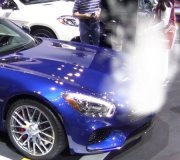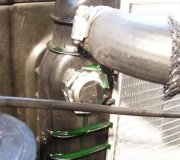The problem started with a leaky coolant reservoir, which caused moderate steam from engine bay with vehicle at idle in parking lot. Coolant temperature gauge did not read high.
I replaced coolant reservoir (which came with new reservoir cap) (there is no radiator cap, per say). During the test drive I again experienced steam from engine bay (a lot more). This time, I found that a coolant hose plastic "T" connection towards the back of the engine cracked/broke. Yes, I tested it at idle before driving, and it was fine. The engine coolant temperature still did not read high as I quickly pulled over.
I then replaced "t" connection, and all seemed fine. Coolant in reservoir is normal at idle and does not overflow even at highway speeds. However, the coolant "bubbles" to varying degrees - based on how hot the engine is (eventually looks like boiling. Bubbles are large). On a warm-ish day (75F) with traffic, scan tool shows ECT 120-150F. "Bubbles" are steady, but no overflow.
If I park and increase the engine to 3,000 RPMs for 5-10 minutes, the reservoir coolant will eventually excitedly "boil" and overflow. I've also seen coolant come past the reservoir cap (note, this is a new cap that came with new reservoir).
From what I've read, these symptoms suggest a blown head gasket. However, I have no milky substance in the oil cap area. Oil looks fine. No perceived loss of power. No black or white smoke from tailpipe.
So, I rented a block tester (blue liquid w/ tube). For most of the test, it stayed blue (even with some "bubbling"). However, once the bubbling got more vigorous - the plastic tester tub started to warp/melt, and the liquid changed to yellow. ECT was around 165F. I believe this again points to the head gasket. But I'm not sure if the test is valid when liquid is hot enough to melt tester (?).
In telling a buddy/mechanic about this, he suggested perhaps air was caught in the coolant system. There is no coolant bleeder valve on this vehicle. Dealer service information suggests it self-burps when driven. So, I drove/cooled/refilled as needed. Several times. Result was the same. The car is fine most of the time. If I rev the engine when parked, coolant reservoir will overflow when ECT gets up to 165F.
Other points to consider. The heater core seems partially blocked. In winter, driver got "ok" heat - but passenger got cool air. This is probably not helping things, but my guess is it's not the primary issue.
The reverse flush of radiator, block, and heater core showed no major discoloration or debris/particles. I am presently doing a chemical flush. Took thermostat out (put housing back in) and am driving car with cabin heater on high. Short trips. Keeping ECT under 150F.
Anything else I can test/try? Is compression test of engine cylinders next move to confirm head gasket? Since this only seems to happen with engine is at 165F, would I have to do compression test with engine hot as well?
Any chance this could be Engine Coolant Temp sensor? If water boils at 212F, how can reservoir coolant be boiling at 165F? Maybe the engine temperature is really much hotter, and the fan should be on? Or are the "bubbles" in coolant really exhaust in coolant system from head gasket leak? Radiator fan will sometimes turn on after cold start, and then turn off, which seems strange. It stays off for the most part. I've read that the fan should turn on at 180F - but I get coolant overflow at 165F.
Any advice is much appreciated. Thanks for your time.
Monday, June 12th, 2023 AT 8:57 PM


